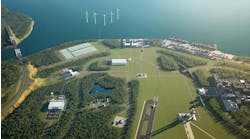Responding to the COVID-19 threat, Moderna Therapeutics is one of a handful of drugmakers that successfully leveraged mRNA technology to slash the time needed to develop, test and gain approval for a new vaccine. A process that had never been completed in fewer than four years had taken less than one, promising to save untold lives.
And while much credit has been rightly ascribed to new, whiz-bang mRNA genetic technology, an early commitment to state-of-the-art automation and information technology played a significant role as well, according to Roland Smith, vice president of business and digital GXP systems, Moderna. Interviewed by Jim Nyquist, chair of Emerson’s systems and software business, Smith was appropriately front-and-center for the "Speed to market keynote" session on Feb. 2 during the Emerson Exchange Virtual Series.
Moderna announced plans to build its new, $110 million mRNA clinical manufacturing facility in September 2016 and completed construction in early 2018. The facility was created to function as an early development engine for advancing the company’s mRNA drug pipeline.
"Obviously, a key first factor in our success was the decision in early 2016 to build a new manufacturing site after our first positive clinical trials using mRNA technology,” Smith said. “We also made the decision to be digital first, building a native digital manufacturing site that leveraged mature toolkits, such as those in Emerson’s Syncade MES and DeltaV solutions."
The third contributor to Moderna’s success was a commitment to data analytics, Smith added. A fundamental difference between clinical manufacturing and commercial production is that at the clinical stage the focus is on learning, so you want all the data you can get. "From day one, in every system we stood up, we tried to integrate the data, get it out and use it,” Smith explained. “So, as of today, we have almost a billion rows of data that we've learned from."
Compared to only five years ago, equipment has gotten smarter and, combined with the platform nature of the company’s mRNA technology, has allowed the company to create more flexible, product-agnostic recipes. "This allowed us to pass down the parameters and call different building blocks from the MES system, resulting in a lighter, more flexible control layer, so we can bring new products into the facility much more quickly by simply changing a few lines of code in the mRNA and a few parameter sets in our MES system.
"The cloud has also been a key enabler, providing the ability to scale quickly, and build redundancy and resiliency in support of our systems," Smith continued. "The data warehousing capabilities we’re using today didn't exist five years ago, and the speed and ability to process that data continues to accelerate."
From a project perspective, Smith stressed the need to start early, think big and break down silos between functional departments as well as between organizations. "We did this by facilitating cross-functional visioning sessions in a room together," Smith explained.
Even pre-COVID, Moderna saw cycle times reduced from two weeks to five or six days. Digital workflows eliminated unproductive waiting time, reducing variability in turn. Batch-record review now goes much more quickly, and manual error rates have been cut by 80%. Further, digitalization has reduced operator labor by 30-40%.
In summary, Smith said, "Compliance, operational excellence and data were the guiding principles in everything we did."
For the full Moderna story, visit emersonexchange.org to register and view Smith's presentation on demand.






